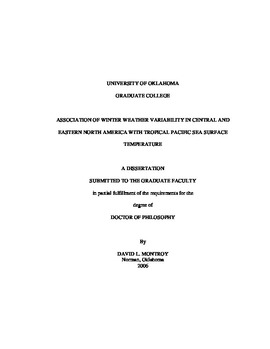| dc.contributor.advisor | Lamb, Peter J., | en_US |
| dc.contributor.author | Montroy, David L. | en_US |
| dc.date.accessioned | 2013-08-16T12:20:30Z | |
| dc.date.available | 2013-08-16T12:20:30Z | |
| dc.date.issued | 2006 | en_US |
| dc.identifier.uri | https://hdl.handle.net/11244/1131 | |
| dc.description.abstract | The analysis of North American daily precipitation and temperature distributions during warm and cold TP SSTA events identified unique changes. In the southeastern U.S., increased precipitation during January-March warm TP SSTA events was generally linked to more frequent daily precipitation totals above 10 mm, while the increased November precipitation in similar regions resulted from increased daily precipitation totals of all amounts. Further, below average January precipitation in the southwestern Appalachian Mountain region during warm TP SSTA events was associated with the lack of occurrence of very large (>25 mm) daily precipitation totals. During cold TP SSTA events, below average November precipitation principally was associated with reduced frequency of larger (>10 mm) precipitation events. Similarly unique relationships were identified in monthly average daily temperature extremes. Cooler than average February daily minimum temperatures in the central U.S. Great Plains mainly arose from the lack of occurrence of observations well below the monthly mean. Also, cooler than average daily maximum temperatures in the southern U.S. were associated principally with relatively few observations well above the monthly mean. For many other locations, the shifts in the daily maximum and minimum temperature distributions were quantified. | en_US |
| dc.description.abstract | The present research contributes to the need for such a linkage using a comprehensive set of analyses relating monthly composite patterns to daily atmospheric flow. First, the approach used in an earlier analysis of precipitation data is applied to monthly averages of daily maximum/minimum temperatures during warm and cold TP SSTA events, providing a set of regions with notable precipitation or temperature anomalies during warm and cold TP SSTA events. The associated series of daily precipitation and temperature anomalies during warm TP SSTA events are examined to document the change in the frequency of daily observations, the duration of consecutive days of daily anomalies, and the antecedent North Pacific-North American atmospheric conditions. Additionally, for all results, the modulation of the TP SSTA-North American teleconnections by other atmospheric modes is examined. | en_US |
| dc.description.abstract | The surface climate anomalies with the longest duration are the temperature anomalies in the northern U.S. Great Plains and south-central Canada during warm TP SSTA events. During warm TP SSTA events, these regions observed noticeably warmer than average temperatures that last for as many as 14 consecutive days during December-March. Other regions exhibited anomalies with shorter durations. For all regions, the key feature was the location of positive geopotential height anomalies located over North America and the placement of negative geopotential height anomalies in the north Pacific Ocean. This anomalous upper tropospheric longwave pattern develops as a cyclonic system moves off northeast Asia into the north Pacific Ocean to the region of favorable development north of the TP SSTAs and remains there until dissipating before another system moves off northeast Asia. | en_US |
| dc.description.abstract | Many authors have statistically documented the seasonal precipitation and temperature patterns linked to tropical Pacific (TP) SST anomaly (SSTA) events. Only recently have changes in the daily distributions of observed surface precipitation and temperature begun to be analyzed in this context. But no extensive linkage of TP SSTs with daily North American weather observations has been established. | en_US |
| dc.description.abstract | The Arctic Oscillation (AO) was shown to materially modify the teleconnection between the TP and North American climate in both its positive and negative phases. Particularly, the AO modulates the placement of the negative geopotential height anomalies in the north Pacific Ocean and the positive geopotential height anomalies over North America. These changes in atmospheric flow then bring about differences in the associated precipitation and temperature anomalies. | en_US |
| dc.description.abstract | The monthly composite temperature analyses demonstrated that, similar to the earlier precipitation analysis, the patterns of monthly average daily temperature extremes yielded previously unknown regions associated with TP SSTAs. In particular, new regions found to be characterized by strong temperature anomalies included the eastern U.S. (warm, December), the central U.S. Great Plains (warm, February), and the U.S. Great Plains (cool, October-November) during warm TP SSTA events, and south central Canada (March-April) and the southern U.S. Great Plains (warm, December-April) during cold TP SSTA events. Additionally, the observed monthly precipitation/temperature anomalies during SSTA events after 1992 exhibited strong similarities to the features common to the 1950-92 events. | en_US |
| dc.format.extent | xxv, 198 leaves : | en_US |
| dc.subject | Atmospheric Sciences. | en_US |
| dc.subject | Temperature measurements. | en_US |
| dc.subject | Ocean temperature. | en_US |
| dc.subject | Climatic changes. | en_US |
| dc.subject | Precipitation anomalies North America. | en_US |
| dc.title | Association of winter weather variability in Central and Eastern North America with tropical Pacific sea surface temperature. | en_US |
| dc.type | Thesis | en_US |
| dc.thesis.degree | Ph.D. | en_US |
| dc.thesis.degreeDiscipline | School of Meteorology | en_US |
| dc.note | Adviser: Peter J. Lamb. | en_US |
| dc.note | Source: Dissertation Abstracts International, Volume: 67-11, Section: B, page: 6254. | en_US |
| ou.identifier | (UMI)AAI3242289 | en_US |
| ou.group | College of Atmospheric & Geographic Sciences::School of Meteorology | |
